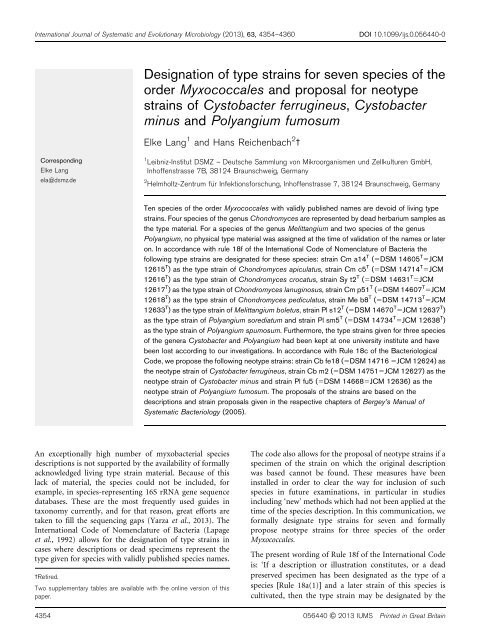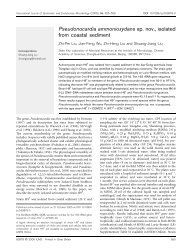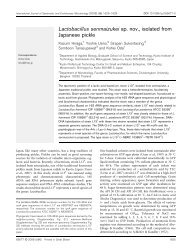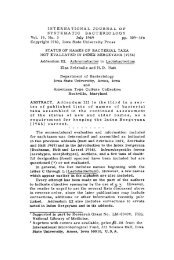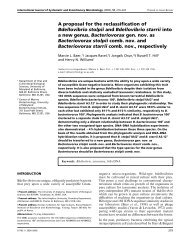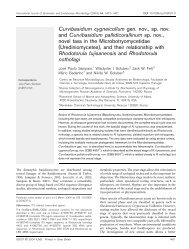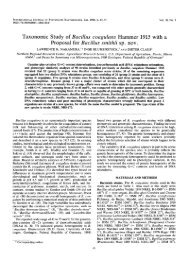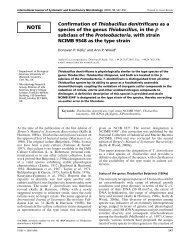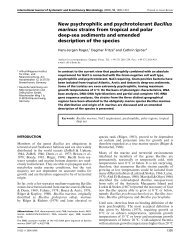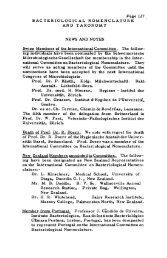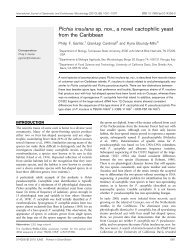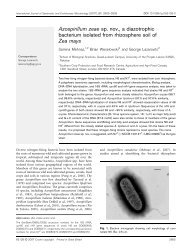Designation of type strains for seven species of the order ...
Designation of type strains for seven species of the order ...
Designation of type strains for seven species of the order ...
Create successful ePaper yourself
Turn your PDF publications into a flip-book with our unique Google optimized e-Paper software.
International Journal <strong>of</strong> Systematic and Evolutionary Microbiology (2013), 63, 4354–4360<br />
DOI 10.1099/ijs.0.056440-0<br />
<strong>Designation</strong> <strong>of</strong> <strong>type</strong> <strong>strains</strong> <strong>for</strong> <strong>seven</strong> <strong>species</strong> <strong>of</strong> <strong>the</strong><br />
<strong>order</strong> Myxococcales and proposal <strong>for</strong> neo<strong>type</strong><br />
<strong>strains</strong> <strong>of</strong> Cystobacter ferrugineus, Cystobacter<br />
minus and Polyangium fumosum<br />
Elke Lang 1 and Hans Reichenbach 2 3<br />
Corresponding<br />
Elke Lang<br />
ela@dsmz.de<br />
1 Leibniz-Institut DSMZ – Deutsche Sammlung von Mikroorganismen und Zellkulturen GmbH,<br />
Inh<strong>of</strong>fenstrasse 7B, 38124 Braunschweig, Germany<br />
2 Helmholtz-Zentrum für Infektions<strong>for</strong>schung, Inh<strong>of</strong>fenstrasse 7, 38124 Braunschweig, Germany<br />
Ten <strong>species</strong> <strong>of</strong> <strong>the</strong> <strong>order</strong> Myxococcales with validly published names are devoid <strong>of</strong> living <strong>type</strong><br />
<strong>strains</strong>. Four <strong>species</strong> <strong>of</strong> <strong>the</strong> genus Chondromyces are represented by dead herbarium samples as<br />
<strong>the</strong> <strong>type</strong> material. For a <strong>species</strong> <strong>of</strong> <strong>the</strong> genus Melittangium and two <strong>species</strong> <strong>of</strong> <strong>the</strong> genus<br />
Polyangium, no physical <strong>type</strong> material was assigned at <strong>the</strong> time <strong>of</strong> validation <strong>of</strong> <strong>the</strong> names or later<br />
on. In accordance with rule 18f <strong>of</strong> <strong>the</strong> International Code <strong>of</strong> Nomenclature <strong>of</strong> Bacteria <strong>the</strong><br />
following <strong>type</strong> <strong>strains</strong> are designated <strong>for</strong> <strong>the</strong>se <strong>species</strong>: strain Cm a14 T (5DSM 14605 T 5JCM<br />
12615 T ) as <strong>the</strong> <strong>type</strong> strain <strong>of</strong> Chondromyces apiculatus, strain Cm c5 T (5DSM 14714 T 5JCM<br />
12616 T ) as <strong>the</strong> <strong>type</strong> strain <strong>of</strong> Chondromyces crocatus, strain Sy t2 T (5DSM 14631 T 5JCM<br />
12617 T ) as <strong>the</strong> <strong>type</strong> strain <strong>of</strong> Chondromyces lanuginosus, strain Cm p51 T (5DSM 14607 T 5JCM<br />
12618 T ) as <strong>the</strong> <strong>type</strong> strain <strong>of</strong> Chondromyces pediculatus, strain Me b8 T (5DSM 14713 T 5JCM<br />
12633 T ) as <strong>the</strong> <strong>type</strong> strain <strong>of</strong> Melittangium boletus, strain Pl s12 T (5DSM 14670 T 5JCM 12637 T )<br />
as <strong>the</strong> <strong>type</strong> strain <strong>of</strong> Polyangium sorediatum and strain Pl sm5 T (5DSM 14734 T 5JCM 12638 T )<br />
as <strong>the</strong> <strong>type</strong> strain <strong>of</strong> Polyangium spumosum. Fur<strong>the</strong>rmore, <strong>the</strong> <strong>type</strong> <strong>strains</strong> given <strong>for</strong> three <strong>species</strong><br />
<strong>of</strong> <strong>the</strong> genera Cystobacter and Polyangium had been kept at one university institute and have<br />
been lost according to our investigations. In accordance with Rule 18c <strong>of</strong> <strong>the</strong> Bacteriological<br />
Code, we propose <strong>the</strong> following neo<strong>type</strong> <strong>strains</strong>: strain Cb fe18 (5DSM 14716 5JCM 12624) as<br />
<strong>the</strong> neo<strong>type</strong> strain <strong>of</strong> Cystobacter ferrugineus, strain Cb m2 (5DSM 147515JCM 12627) as <strong>the</strong><br />
neo<strong>type</strong> strain <strong>of</strong> Cystobacter minus and strain Pl fu5 (5DSM 146685JCM 12636) as <strong>the</strong><br />
neo<strong>type</strong> strain <strong>of</strong> Polyangium fumosum. The proposals <strong>of</strong> <strong>the</strong> <strong>strains</strong> are based on <strong>the</strong><br />
descriptions and strain proposals given in <strong>the</strong> respective chapters <strong>of</strong> Bergey’s Manual <strong>of</strong><br />
Systematic Bacteriology (2005).<br />
An exceptionally high number <strong>of</strong> myxobacterial <strong>species</strong><br />
descriptions is not supported by <strong>the</strong> availability <strong>of</strong> <strong>for</strong>mally<br />
acknowledged living <strong>type</strong> strain material. Because <strong>of</strong> this<br />
lack <strong>of</strong> material, <strong>the</strong> <strong>species</strong> could not be included, <strong>for</strong><br />
example, in <strong>species</strong>-representing 16S rRNA gene sequence<br />
databases. These are <strong>the</strong> most frequently used guides in<br />
taxonomy currently, and <strong>for</strong> that reason, great ef<strong>for</strong>ts are<br />
taken to fill <strong>the</strong> sequencing gaps (Yarza et al., 2013). The<br />
International Code <strong>of</strong> Nomenclature <strong>of</strong> Bacteria (Lapage<br />
et al., 1992) allows <strong>for</strong> <strong>the</strong> designation <strong>of</strong> <strong>type</strong> <strong>strains</strong> in<br />
cases where descriptions or dead specimens represent <strong>the</strong><br />
<strong>type</strong> given <strong>for</strong> <strong>species</strong> with validly published <strong>species</strong> names.<br />
3Retired.<br />
Two supplementary tables are available with <strong>the</strong> online version <strong>of</strong> this<br />
paper.<br />
The code also allows <strong>for</strong> <strong>the</strong> proposal <strong>of</strong> neo<strong>type</strong> <strong>strains</strong> if a<br />
specimen <strong>of</strong> <strong>the</strong> strain on which <strong>the</strong> original description<br />
was based cannot be found. These measures have been<br />
installed in <strong>order</strong> to clear <strong>the</strong> way <strong>for</strong> inclusion <strong>of</strong> such<br />
<strong>species</strong> in future examinations, in particular in studies<br />
including ‘new’ methods which had not been applied at <strong>the</strong><br />
time <strong>of</strong> <strong>the</strong> <strong>species</strong> description. In this communication, we<br />
<strong>for</strong>mally designate <strong>type</strong> <strong>strains</strong> <strong>for</strong> <strong>seven</strong> and <strong>for</strong>mally<br />
propose neo<strong>type</strong> <strong>strains</strong> <strong>for</strong> three <strong>species</strong> <strong>of</strong> <strong>the</strong> <strong>order</strong><br />
Myxococcales.<br />
The present wording <strong>of</strong> Rule 18f <strong>of</strong> <strong>the</strong> International Code<br />
is: ‘If a description or illustration constitutes, or a dead<br />
preserved specimen has been designated as <strong>the</strong> <strong>type</strong> <strong>of</strong> a<br />
<strong>species</strong> [Rule 18a(1)] and a later strain <strong>of</strong> this <strong>species</strong> is<br />
cultivated, <strong>the</strong>n <strong>the</strong> <strong>type</strong> strain may be designated by <strong>the</strong><br />
4354 056440 G 2013 IUMS Printed in Great Britain
http://ijs.sgmjournals.org 4355<br />
Table 1. Myxobacterial <strong>species</strong> <strong>for</strong> which a cultivable <strong>type</strong> strain or neo<strong>type</strong> strain is <strong>for</strong>mally proposed and <strong>the</strong> 16S rRNA sequences <strong>of</strong> <strong>the</strong> proposed neo<strong>type</strong> <strong>strains</strong>. AL, <strong>type</strong><br />
strain as given in Approved Lists (Skerman et al., 1980). VL, <strong>type</strong>s as given in Validation List No 31 (Brockman, 1989b, c)<br />
Species name and authors <strong>of</strong> <strong>the</strong><br />
<strong>species</strong> description<br />
Type strain in<br />
Approved Lists<br />
Designated <strong>type</strong><br />
strain<br />
DSM number <strong>of</strong><br />
<strong>the</strong> <strong>type</strong> strain<br />
JCM number <strong>of</strong><br />
<strong>the</strong> <strong>type</strong> strain<br />
Figure No.<br />
Accession number <strong>of</strong><br />
<strong>the</strong> 16S rRNA gene<br />
sequence<br />
Reference<br />
Chondromyces apiculatus Thaxter 1897 TC 4481 T AL Cm a14 T DSM 14605 T JCM 12615 T 1 AJ233938 Reichenbach (2005a)<br />
Chondromyces crocatus Berkeley and TC 601 T AL Cm c5 T DSM 14714 T JCM 12616 T 2 GU207874 Reichenbach (2005a)<br />
Curtis 1874; <strong>type</strong> <strong>species</strong> <strong>of</strong> <strong>the</strong> genus<br />
Chondromyces lanuginosus K<strong>of</strong>ler 1913 TC 4494 T AL Sy t2 T DSM 14631 T JCM 12617 T 3 AJ233939 Reichenbach (2005a)<br />
Chondromyces pediculatus Thaxter 1904 TC 4524 T AL Cm p51 T DSM 14607 T JCM 12618 T 4 GU207875 Reichenbach (2005a)<br />
Melittangium boletus Jahn 1924; <strong>type</strong> ‘Not cultivated’ AL Me b8 T DSM 14713 T JCM 12633 T 5 AJ233908 Reichenbach (2005c)<br />
<strong>species</strong> <strong>of</strong> <strong>the</strong> genus<br />
Polyangium sorediatum (ex Thaxter Description in Pl s12 T DSM 14670 T JCM 12637 T 6 GU207880 Reichenbach (2005d)<br />
1904) Brockman 1989<br />
Brockman VL<br />
Polyangium spumosum (ex<br />
Krzemieniewska and Krzemieniewski<br />
1927) Brockman 1989<br />
Description in<br />
Brockman VL<br />
Pl sm5 T DSM 14734 T JCM 12638 T 7 GU207881 Reichenbach (2005d)<br />
Cystobacter ferrugineus (Krzemieniewska<br />
and Krzemieniewski 1927) McCurdy<br />
1970<br />
Cystobacter minus (Krzemieniewska and<br />
Krzemieniewski 1926) McCurdy 1970<br />
Polyangium fumosum Krzemieniewska<br />
and Krzemieniewski 1930<br />
Proposed neo<strong>type</strong><br />
strain<br />
DSM number <strong>of</strong><br />
<strong>the</strong> neo<strong>type</strong><br />
strain<br />
JCM number <strong>of</strong><br />
<strong>the</strong> neo<strong>type</strong> strain<br />
Windsor M-203 T AL Cb fe18 DSM 14716 JCM 12624 8 NR_025343; AJ233901;<br />
DQ768112<br />
Reichenbach (2005b)<br />
Windsor M-307 T AL Cb m2 DSM 14751 JCM 12627 9 AJ233903; DQ768113 Reichenbach (2005b)<br />
Windsor M-257 T AL Pl fu5 DSM 14668 JCM 12636 10 GU207879 Reichenbach (2005d)<br />
(Neo-)Type <strong>strains</strong> <strong>for</strong> <strong>species</strong> <strong>of</strong> myxobacteria
E. Lang and H. Reichenbach<br />
(a)<br />
(b)<br />
(a)<br />
Fig. 1. Chondromyces apiculatus. (a) Drawing from Thaxter<br />
(1897), plate XXX on pages 405–406. (b) Fruiting body (bar,<br />
100 mm) and vegetative cells (insert; bar, 10 mm) <strong>of</strong> Cm a14 T .<br />
person who isolated <strong>the</strong> strain or by a subsequent author.<br />
This <strong>type</strong> strain shall <strong>the</strong>n replace <strong>the</strong> description, illustration<br />
or preserved specimen as <strong>the</strong> nomenclatural <strong>type</strong>. The<br />
designation <strong>of</strong> a <strong>type</strong> strain in this manner must be published<br />
in <strong>the</strong> IJSB/IJSEM, <strong>the</strong> authorship and date <strong>of</strong> priority <strong>of</strong><br />
publication being determined by <strong>the</strong> effective and valid<br />
publication <strong>of</strong> <strong>the</strong> name by <strong>the</strong> original authors (Rule 24b)’.<br />
The presently designated <strong>type</strong> <strong>strains</strong> <strong>of</strong> <strong>the</strong> <strong>species</strong><br />
Chondromyces apiculatus (Thaxter, 1897), Chondromyces<br />
crocatus (Berkeley & Curtis, 1874), Chondromyces<br />
lanuginosus (K<strong>of</strong>ler, 1913) and Chondromyces pediculatus<br />
(Thaxter, 1904) are dead herbarium specimens in <strong>the</strong><br />
Thaxter collection (TC), housed in <strong>the</strong> Farlow Herbarium,<br />
Harvard University, Cambridge, USA (Table 1). Howard<br />
McCurdy studied myxobacteria at <strong>the</strong> University <strong>of</strong><br />
Windsor, Ontario, Canada during <strong>the</strong> period around<br />
1960–1970. He assigned specific samples <strong>of</strong> <strong>the</strong> Thaxter<br />
collection as <strong>the</strong> <strong>type</strong>s <strong>of</strong> <strong>the</strong>se <strong>species</strong> (McCurdy, 1971). The<br />
<strong>species</strong> names were included in <strong>the</strong> Approved Lists<br />
(b)<br />
(a)<br />
(b)<br />
Fig. 2. Chondromyces crocatus. (a) Drawing from Berkeley<br />
(1857), page 313. (b) Fruiting bodies <strong>of</strong> Cm c5 T . Bar, 500 mm.<br />
Fig. 3. Chondromyces lanuginosus. (a) Figures from K<strong>of</strong>ler (1913),<br />
Figs 1–3 on page 877 depict Chondromyces lanuginosus.<br />
Courtesy Österreichische Akademie der Wissenschaften. (b)<br />
Fruiting body <strong>of</strong> Sy t2 T . Bar, 100 mm.<br />
4356 International Journal <strong>of</strong> Systematic and Evolutionary Microbiology 63
(Neo-)Type <strong>strains</strong> <strong>for</strong> <strong>species</strong> <strong>of</strong> myxobacteria<br />
(a)<br />
11<br />
12<br />
7 8<br />
10 9<br />
13<br />
(b)<br />
Fig. 4. Chondromyces pediculatus. (a) Drawing from Thaxter (1904),<br />
plate XXVI on page 411; nos 7–13 depict Chondromyces<br />
pediculatus. (b) Fruiting body <strong>of</strong> Cm p51 T .Bar100mm.<br />
(Skerman et al., 1980). According to a curator <strong>of</strong> <strong>the</strong><br />
herbarium, <strong>the</strong> specimen <strong>for</strong> Chondromyces lanuginosus<br />
seems to be lost whereas <strong>the</strong> o<strong>the</strong>r three specimens are still<br />
<strong>the</strong>re, dried on <strong>the</strong> original substrates, accompanied by some<br />
slides.<br />
For <strong>the</strong> <strong>species</strong> Melittangium boletus (Jahn, 1924), Polyangium<br />
sorediatum (Brockman, 1989a) and Polyangium spumosum<br />
(Brockman, 1989a) no physical <strong>type</strong> <strong>strains</strong> were assigned in<br />
<strong>the</strong> Approved Lists (Skerman et al., 1980) or in Validation List<br />
No. 31 (Brockman, 1989b,c), respectively. Instead, <strong>the</strong><br />
descriptions <strong>of</strong> Brockman (1989a) or simply <strong>the</strong> statement<br />
‘not cultivated’ are given.<br />
Bergey’s Manual <strong>of</strong> Systematic Bacteriology, second<br />
edition, includes comprehensive chapters about <strong>the</strong><br />
members <strong>of</strong> <strong>the</strong> <strong>order</strong> Myxococcales. Reichenbach (2005a,<br />
b, c, d, e) are <strong>the</strong> chapters relevant to <strong>the</strong> taxa mentioned in<br />
this paper. These chapters are based on <strong>the</strong> experience and<br />
knowledge accumulated during 40 years <strong>of</strong> intense<br />
investigations on myxobacteria and were written after<br />
more than 3000 myxobacterial <strong>strains</strong> had been isolated.<br />
Based on <strong>the</strong> original <strong>species</strong> descriptions, appropriate<br />
<strong>strains</strong> were selected and described as <strong>the</strong> <strong>type</strong> <strong>strains</strong> <strong>of</strong> <strong>the</strong><br />
respective <strong>species</strong> (Table 1). However, it has not been<br />
<strong>for</strong>mally proposed in <strong>the</strong> IJSEM until now to accept <strong>the</strong>se<br />
<strong>strains</strong> as <strong>the</strong> <strong>type</strong> <strong>strains</strong>.<br />
For <strong>the</strong> reason that presently dead preserved material<br />
constitutes-, or a description has been designated-, <strong>the</strong> <strong>type</strong><br />
strain <strong>of</strong> <strong>the</strong> mentioned <strong>species</strong>, or no <strong>type</strong> strain has been<br />
assigned, it is <strong>for</strong>mally proposed that <strong>the</strong> <strong>strains</strong> selected by<br />
Reichenbach shall be designated <strong>the</strong> <strong>type</strong> <strong>strains</strong> <strong>of</strong> <strong>the</strong><br />
respective <strong>species</strong> according to Rule 18f. The proposed <strong>type</strong><br />
<strong>strains</strong> listed in Table 1 shall replace <strong>the</strong> dead specimen or<br />
descriptions. These are Chondromyces apiculatus Cm a14 T ,<br />
Chondromyces crocatus Cm c5 T , Chondromyces lanuginosus<br />
Sy t2 T , Chondromyces pediculatus Cm p51 T , M. boletus Me<br />
b8 T , P. sorediatum Pl s12 T and P. spumosum Pl sm5 T . The<br />
prerequisite <strong>for</strong> <strong>the</strong> acceptance <strong>of</strong> <strong>type</strong> <strong>strains</strong>, <strong>the</strong>ir deposit<br />
and availability in two culture collections is achieved. The<br />
designation <strong>of</strong> <strong>the</strong> <strong>type</strong> <strong>strains</strong> is based on <strong>the</strong> descriptions<br />
given in <strong>the</strong> respective chapters <strong>of</strong> Bergey’s Manual<br />
(Reichenbach 2005a, c, d). In <strong>order</strong> to facilitate <strong>the</strong><br />
comparison <strong>of</strong> <strong>the</strong>se recent descriptions with those <strong>of</strong> <strong>the</strong><br />
authors who originally proposed, revived or emended <strong>the</strong><br />
<strong>species</strong> <strong>the</strong>se original descriptions are assembled in Table<br />
S1 available in IJSEM Online. The fatty acid composition <strong>of</strong><br />
<strong>the</strong> proposed <strong>type</strong> <strong>strains</strong> are given in Table S2 (Garcia<br />
et al., 2011). The figures from <strong>the</strong> original descriptions and<br />
<strong>of</strong> <strong>the</strong> proposed <strong>type</strong> <strong>strains</strong> are shown face to face with<br />
figures showing <strong>the</strong> proposed <strong>type</strong> <strong>strains</strong> in Figs 1–10.<br />
The Bacteriological Code also allows <strong>for</strong> <strong>the</strong> proposal <strong>of</strong><br />
neo<strong>type</strong> <strong>strains</strong> according to Rule 18c: ‘If a strain on which<br />
<strong>the</strong> original description was based cannot be found, a<br />
neo<strong>type</strong> strain may be proposed. A neo<strong>type</strong> strain must be<br />
proposed (proposed neo<strong>type</strong>) in <strong>the</strong> IJSB, toge<strong>the</strong>r with<br />
citation <strong>of</strong> <strong>the</strong> author(s) <strong>of</strong> <strong>the</strong> name, a description or<br />
(a) (b) (c)<br />
Fig. 5. Melittangium boletus. (a) Drawing from Jahn (1924), plate II, Fig. 17 on page 78. Courtesy Bornträger-Cramer,<br />
www.borntraeger-cramer.de. (b) and (c) Fruiting bodies <strong>of</strong> Me b8 T . Bars, 120 and 80 mm, respectively.<br />
http://ijs.sgmjournals.org 4357
E. Lang and H. Reichenbach<br />
(a)<br />
22<br />
28<br />
24<br />
29<br />
30<br />
23<br />
27<br />
25<br />
26<br />
Fig. 6. Polyangium sorediatum. (a) Drawing from Thaxter (1904),<br />
plate XXVII. Nos 22–30 depict P. sorediatum. (b and c) Fruiting<br />
bodies <strong>of</strong> PI s12 T . Insert: crushed sporangium releasing <strong>the</strong> single<br />
sporangioles. Bars, 200 mm.<br />
(b)<br />
(c)<br />
reference to an effectively published description and a<br />
record <strong>of</strong> <strong>the</strong> permanently established culture collection(s)<br />
where <strong>the</strong> strain is deposited (see also Note 1 to Rule 24a)’.<br />
The <strong>species</strong> Cystobacter ferrugineus, Cystobacter minus and<br />
Polyangium fumosum were first described by Krzemieniewska<br />
& Krzemieniewski (1926, 1927, 1930). McCurdy assigned<br />
three <strong>of</strong> his isolates as <strong>the</strong> <strong>type</strong> <strong>strains</strong> <strong>for</strong> <strong>the</strong> abovementioned<br />
three <strong>species</strong> (McCurdy, 1970; Table 1). The<br />
<strong>species</strong> names and <strong>type</strong> <strong>strains</strong> were included in <strong>the</strong><br />
Approved Lists (Skerman et al., 1980) but <strong>the</strong>y have never<br />
been deposited in a culture collection to <strong>the</strong> best <strong>of</strong> our<br />
knowledge. In 2007, we wrote a letter to <strong>the</strong> head <strong>of</strong> <strong>the</strong><br />
microbiology laboratory <strong>of</strong> <strong>the</strong> University <strong>of</strong> Windsor with<br />
<strong>the</strong> request <strong>for</strong> subcultures <strong>of</strong> <strong>the</strong> <strong>strains</strong> Cystobacter<br />
ferrugineus M-203 T , Cystobacter minus M-307 T and P.<br />
fumosum M257 T . Even though <strong>the</strong> importance <strong>for</strong> microbial<br />
taxonomy was stressed <strong>the</strong>re was no response. In 2012,<br />
ano<strong>the</strong>r attempt to contact <strong>the</strong> department at Windsor<br />
University was more successful in <strong>the</strong> respect that we received<br />
answers from two colleagues at Windsor and from H. D.<br />
McCurdy who retired several years ago. However, <strong>the</strong>y<br />
in<strong>for</strong>med us that <strong>the</strong>y cannot find <strong>the</strong> samples. Since 1981,<br />
<strong>the</strong>re have been no scientific papers originating from <strong>the</strong><br />
(a)<br />
(b)<br />
(c)<br />
(d)<br />
Fig. 7. Polyangium spumosum. (a) Figures from Krzemieniewska & Krzemieniewski (1926), plate V; no. 19 depicts P.<br />
spumosum and from Krzemieniewska & Krzemieniewski (1930), plate XVI; nos 10–12 depict P. spumosum. Courtesy <strong>of</strong> <strong>the</strong><br />
Polish Botanical Society. (b–d) Degenerated fruiting bodies <strong>of</strong> PI sm5 T . Bars, 500, 100 and 250 mm, respectively.<br />
4358 International Journal <strong>of</strong> Systematic and Evolutionary Microbiology 63
(Neo-)Type <strong>strains</strong> <strong>for</strong> <strong>species</strong> <strong>of</strong> myxobacteria<br />
(a)<br />
(b)<br />
(a)<br />
(c)<br />
(d)<br />
(b)<br />
Fig. 8. Cystobacter ferrugineus. (a) Figures from McCurdy (1970).<br />
(b–d) Strain Cb fe18, (b) myxospores and (c) fruiting bodies on<br />
Escherichia coli as food bacteria and (d) on a cellulose plate. Bars,<br />
10 mm, 1 mm and 10 mm, respectively.<br />
(c)<br />
(a)<br />
(b)<br />
(d)<br />
(c)<br />
Fig. 9. Cystobacter minus. (a), Figures from McCurdy (1970).<br />
(b and c), Fruiting bodies <strong>of</strong> Cb m2. Bars, 500 mm and 200 mm,<br />
respectively.<br />
Fig. 10. Polyangium fumosum. (a) Drawing from Krzemieniewska<br />
& Krzemieniewski (1930), plate XVI, nos 6–9 depict P. fumosum.<br />
Courtesy <strong>of</strong> <strong>the</strong> Polish Botanical Society. (b) Swarm <strong>of</strong> PI fu5 (bar,<br />
2000 mm) and single sporangium <strong>of</strong> PI fu5 (insert; bar, 100 mm).<br />
(c) Fruiting bodies <strong>of</strong> PI fu5. Bar, 300 mm.<br />
http://ijs.sgmjournals.org 4359
E. Lang and H. Reichenbach<br />
University <strong>of</strong> Windsor dealing with myxobacteria (PubMed),<br />
a fact additionally suggesting that nobody at <strong>the</strong> university<br />
had a research interest to keep <strong>the</strong> cultures alive or, at least,<br />
under surveillance. For that reasons we conclude that <strong>the</strong>se<br />
cultures must have been lost.<br />
Since <strong>the</strong> presently assigned <strong>type</strong> <strong>strains</strong> <strong>of</strong> <strong>the</strong> mentioned<br />
<strong>species</strong> are no longer available as living cultures it is <strong>for</strong>mally<br />
proposed that <strong>the</strong> <strong>strains</strong> selected by Reichenbach shall be<br />
proposed as <strong>the</strong> neo<strong>type</strong> <strong>strains</strong> <strong>of</strong> <strong>the</strong> respective <strong>species</strong> in<br />
accordance with Rule 18c, as given in Table 1. The deposit<br />
and availability <strong>of</strong> <strong>the</strong> neo<strong>type</strong> <strong>strains</strong> from two culture<br />
collections is achieved. The proposals <strong>of</strong> <strong>the</strong> neo<strong>type</strong> <strong>strains</strong><br />
are based on <strong>the</strong> suggestions in (Reichenbach (2005b, d). In<br />
<strong>the</strong>se chapters, <strong>the</strong> <strong>strains</strong> Cystobacter ferrugineus Cb fe18,<br />
Cystobacter minus Cb m2 and P. fumosum Pl fu5 were<br />
proposed as <strong>the</strong> <strong>type</strong> <strong>strains</strong> according to <strong>the</strong> <strong>species</strong><br />
descriptions given in <strong>the</strong> respective chapters which rely on<br />
<strong>the</strong> original <strong>species</strong> descriptions by Krzemieniewska and<br />
Krzemieniewski and McCurdy (Reichenbach 2005b, d).<br />
However, since <strong>type</strong> <strong>strains</strong> have already been assigned <strong>the</strong>se<br />
<strong>strains</strong> have to be proposed as <strong>the</strong> neo<strong>type</strong> <strong>strains</strong> <strong>of</strong> <strong>the</strong><br />
respective <strong>species</strong> according to rule 18c.<br />
Acknowledgements<br />
We are thankful to K. Poling and I. Churchill at Windsor University,<br />
G. Lewis-Gentry at <strong>the</strong> Harvard University Herbaria and H. D.<br />
McCurdy <strong>for</strong> taking <strong>the</strong> ef<strong>for</strong>t to investigate <strong>the</strong> disposition <strong>of</strong> <strong>the</strong><br />
<strong>type</strong> materials.<br />
References<br />
Berkeley, M. J. (1857). Introduction to Cryptogamic Botany. London:<br />
H. Bailliere.<br />
Berkeley, M. J. & Curtis, M. A. (1874). Notices <strong>of</strong> <strong>the</strong> North American<br />
Fungi. Grevillea 3, 49–64.<br />
Brockman, E. R. (1989a). Genus I. Polyangium Link 1809, 42 AL .In<br />
Bergey’s Manual <strong>of</strong> Systematic Bacteriology, vol. 3, pp. 2159–2162.<br />
Edited by J. T. Staley, M. P. Bryant, N. Pfennig & J. G. Holt.<br />
Baltimore: Williams & Wilkins.<br />
Brockman, E. R. (1989b). Polyangium sorediatum nom. rev. In<br />
Validation <strong>of</strong> <strong>the</strong> Publication <strong>of</strong> New Names and New Combinations<br />
Previously Effectively Published Outside <strong>the</strong> IJSB, List No. 31. Int J Syst<br />
Bacteriol 39, 495–497.<br />
Brockman, E. R. (1989c). Polyangium spumosum nom. rev. In<br />
Validation <strong>of</strong> <strong>the</strong> Publication <strong>of</strong> New Names and New Combinations<br />
Previously Effectively Published Outside <strong>the</strong> IJSB, List No. 31. Int J Syst<br />
Bacteriol 39, 495–497.<br />
Garcia, R., Pistorius, D., Stadler, M. & Müller, R. (2011). Fatty<br />
acid-related phylogeny <strong>of</strong> myxobacteria as an approach to discover<br />
polyunsaturated omega-3/6 fatty acids. J Bacteriol 193, 1930–<br />
1942.<br />
Jahn, E. (1924). Beitraege zur Botanischen Protistologie I. Die<br />
Polyangiden. Leipzig: Verlag Gebrueder Borntraeger.<br />
K<strong>of</strong>ler, L. (1913). Die Myxobakterien der Umgebung von Wien.<br />
Sitzungsberichte der Akademie der Wissenschaften in Wien Ma<strong>the</strong>matisch-naturwissenschaftliche<br />
Klasse Abteilung I 122, 845–876.<br />
Krzemieniewska, H. & Krzemieniewski, S. (1926). Miksobacterje<br />
Polski (Die Myxobakterien von Polen). Acta Societatis Botanicorum<br />
Poloniae 4, 1–54.<br />
Krzemieniewska, H. & Krzemieniewski, S. (1927). Miksobacterje<br />
Polski. Uzupelnienie. (Die Myxobakterien von Polen. Anhang). Acta<br />
Societatis Botanicorum Poloniae 5, 79–98.<br />
Krzemieniewska, H. & Krzemieniewski, S. (1930). Miksobakterje<br />
Polski. Czesc Trzecia. (Die Myxobakterien von Polen. III. Teil). Acta<br />
Societatis Botanicorum Poloniae 7, 250–273.<br />
Lapage, S. P., Sneath, P. H. A., Lessel, E. F., Skerman, V. B. D.,<br />
Seeliger, H. P. R. & Clark, W. A. (editors) (1992). International Code <strong>of</strong><br />
Nomenclature <strong>of</strong> Bacteria (1990 Revision). Bacteriological Code.<br />
Washington, DC: American Society <strong>for</strong> Microbiology.<br />
McCurdy, H. D. (1970). Studies on <strong>the</strong> taxonomy <strong>of</strong> <strong>the</strong><br />
Myxobacterales. II. Polyangium and <strong>the</strong> demise <strong>of</strong> <strong>the</strong> Sporangiaceae.<br />
Int J Syst Bacteriol 20, 283–296.<br />
McCurdy, H. D. (1971). Studies on <strong>the</strong> taxonomy <strong>of</strong> <strong>the</strong><br />
Myxobacterales. III. Chondromyces and Stigmatella. Int J Syst<br />
Bacteriol 21, 40–49.<br />
Reichenbach, H. (2005a). Genus III. Chondromyces Berkeley and<br />
Curtis in Berkeley 1874, 64 AL . In Bergey’s Manual <strong>of</strong> Systematic<br />
Bacteriology, 2nd edn, vol. 2, pp. 1121–1129. Edited by D. J. Brenner,<br />
N. R. Krieg & G. M. Garrity. New York: Springer.<br />
Reichenbach, H. (2005b). Genus I. Cystobacter Schroeter 1886, 170 AL .<br />
In Bergey’s Manual <strong>of</strong> Systematic Bacteriology, 2nd edn, vol. 2, pp.<br />
1086–1096. Edited by D. J. Brenner, N. R. Krieg & G. M. Garrity. New<br />
York: Springer.<br />
Reichenbach, H. (2005c). Genus IV. Melittangium Jahn 1924, 7 AL .In<br />
Bergey’s Manual <strong>of</strong> Systematic Bacteriology, 2nd edn, vol. 2, pp. 1101–<br />
1104. Edited by D. J. Brenner, N. R. Krieg & G. M. Garrity. New York:<br />
Springer.<br />
Reichenbach, H. (2005d). Genus I. Polyangium Link 1809, 42 AL .In<br />
Bergey’s Manual <strong>of</strong> Systematic Bacteriology, 2nd edn, vol. 2, pp. 1110–<br />
1118. Edited by D. J. Brenner, N. R. Krieg & G. M. Garrity. New York:<br />
Springer.<br />
Reichenbach, H. (2005e). Order VIII. Myxococcales Tchan, Pochon<br />
and Prévot 1948, 398 AL .InBergey’s Manual <strong>of</strong> Systematic Bacteriology,<br />
2nd edn, vol. 2, pp. 1059–1072. Edited by D. J. Brenner, N. R. Krieg &<br />
G. M. Garrity. New York: Springer.<br />
Skerman, V. B. D., McGowan, V. & Sneath, P. H. A. (1980). Approved<br />
lists <strong>of</strong> bacterial names. Int J Syst Bacteriol 30, 225–420.<br />
Thaxter, R. (1897). Fur<strong>the</strong>r observations on <strong>the</strong> Myxobacteriaceae. Bot<br />
Gaz 23, 395–411.<br />
Thaxter, R. (1904). Notes on <strong>the</strong> Myxobacteriaceae. Bot Gaz 37, 405–<br />
416.<br />
Yarza, P., Spröer, C., Swiderski, J., Mrotzek, N., Spring, S., Tindall,<br />
B. J., Gronow, S., Pukall, R., Klenk, H. P. & o<strong>the</strong>r authors (2013).<br />
Sequencing orphan <strong>species</strong> initiative (SOS): Filling <strong>the</strong> gaps in <strong>the</strong> 16S<br />
rRNA gene sequence database <strong>for</strong> all <strong>species</strong> with validly published<br />
names. Syst Appl Microbiol 36, 69–73.<br />
4360 International Journal <strong>of</strong> Systematic and Evolutionary Microbiology 63


